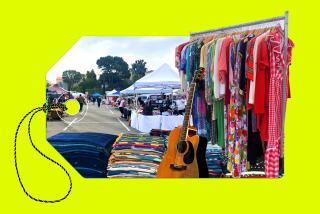From Camden Town Right to Portobello Road, London’s Weekend Flea Markets Are Hopping
LONDON — The young woman sits patiently beside a table displaying her handmade jewelry and her purple and orange hair stiffened into a rig of spikes. Her jewelry is as colorful as she is--rubber bracelets and earrings splashed with iridescent designs, fitted with studs and delicate chains.
Around her are aspiring young designers, artists and artisans, selling everything from hand-sewn hats and clothing to pottery, jewelry and crafts.
One young stallholder offers to pierce his customers’ ears and nose. Nothing is too outrageous at Camden Town’s weekend market.
At the other end of London on Portobello Road, an old man with a shock of white hair and a tweed jacket and looking very much like the college professor he used to be, holds up a glass figure from the 1920s so it catches the sunlight.
“Look at that,” he said, with a tone of reverence. “If you were to put a lamp behind it so that it lit up, it would be very beautiful indeed.”
It doesn’t matter to him whether he sells the piece. Collecting Art Deco is his hobby and his passion. Between customers he absorbs himself in books.
Camden Town and Portobello Road are two of London’s markets that are as varied as the vendors.
Offering everything from Victorian bric-a-brac and costume jewelry to Art Deco, ‘50s kitsch, originally designed clothing, secondhand goods and household items, London’s outdoor markets are as much a part of the shopping scene as Bond Street and Marks and Spencer.
Open throughout the year, these outdoor markets are educational and fun. Many dealers are avid collectors and enjoy talking about their finds, and if you’re inquisitive you can learn a lot about London and its history. In the process you can pick up some excellent bargains.
Of all of London’s outdoor flea markets, Petticoat Lane is probably the most famous--but you won’t find a street of the same name.
This market stretches the length of Middlesex Street, radiating into side streets. Open only on Sunday mornings, it is for the common people who flock here by the thousands to buy kitchen gadgets, sweaters, coats, towels, clothing, accessories, junk and odds and ends.
If you’re looking for pink polyester pants or a plastic vegetable grater, this is the place.
Even if you don’t intend to buy anything, Petticoat Lane is worth visiting just for its vendors, who are among the most talented street hawkers around.
In a kaleidoscope of colors, noises and smells, they vie for shoppers’ attention, each claiming to have the best bargain in all of London.
One vendor, for example, may sell a handy tool that he promises will do everything from sharpening knives to cutting glass, while another may sell two silver rings for--or so he claims--the price of one.
If it’s Saturday, go to Portobello Road. Although some people grumble that this well-known market has disintegrated into a tourist trap, it offers so much variety and undergoes so much transformation as you walk its length that it makes great entertainment.
Beginning as an antiques market, Portobello becomes a produce market and then dissolves into reggae and punk. In its own way, Portobello offers a good study of present-day London.
If you begin your walk on Portobello near Notting Hill Gate station, you’ll be surrounded by stall after stall of Victorian silver and antiques.
Cutlery, silver-plated toast racks, pocket watches, button hooks, pipes, vases, sugar bowls, canes, china and jewelry are spread on tables and shelves along the side of the road and in the many shops and arcades.
Past Elgin Crescent the market becomes one of vegetables and fruit, surrounded by shops with a distinct West Indies flavor.
Indian silk scarfs, reggae records, ethnic restaurants and punk fashion all converge in a strange merging of dreadlocks and hair dyed purple.
Continuing on Portobello Road past the produce market, you will soon come to a highway overpass, under which is a small shopping arcade called Portobello Green. Shops there sell original handmade crafts including jewelry, glass and clothing. Around Portobello Green is a maze of more stalls, selling used clothing, some Art Deco, collectibles and junk. From there it’s just a short walk to Ladbroke Grove station.
If you’re interested in antiques, one of the best sources in town is the New Caledonian Market, also known as Bermondsey Market because it’s held on Bermondsey Square.
Open only on Fridays, this market is for serious collectors and dealers from around the world who arrive early to snatch up the best bargains.
It used to be that customers arrived at 3 a.m. armed with flashlights to fish out the best items, but the law now dictates that bargaining can’t start until 7 a.m.
In addition to some furniture, Bermondsey Market offers silver, glass, china, dolls, clocks, cutlery, jewelry, canes and Victorian odds and ends.
Another good place for antiques is Camden Passage (not to be confused with Camden Town). In a part of London called Islington, this antique market is open for business on Wednesdays and Saturdays. Old books are sold on Thursdays.
A small, pleasant market without the seething crowds that often descend on London’s other sale sites, Camden Passage is made up of several indoor antique arcades and a narrow street dating from the 1760s, and is lined with small boutiques and shops and with vendors who have set up their stalls.
This is a good place to look for period and paste jewelry, clothes, bric-a-brac, silver and odds and ends.
How about some pre-World War II eyeglasses? Or a tea cozy?
For the latest in avant-garde fashions by some of London’s aspiring designers, go to Camden Town where several sprawling markets are held every Saturday and Sunday.
Popular with London’s younger generation, Camden Town is an eclectic and vibrant mix of fashion, ethnic items from India, crafts, Art Deco, ‘50s plastics and kitsch.
Your first stop should be the Electric Ballroom, an indoor market beside the Camden Town underground station featuring original fashions and secondhand clothing, much of it outlandish and outrageous.
Down the road are Camden Market and New Canal Market, two outdoor flea markets with more original and secondhand clothing, accessories and jewelry.
But the main draw of Camden Town is Camden Lock, a maze of tiny lanes and even tinier stalls, that finally open onto a small cobbled courtyard beside a canal.
The Lock has some outdoor cafes, and you can board a boat for a pleasure ride to the London Zoo or Little Venice.
But if you’re interested in Art Deco, don’t stop here. About a 10-minute walk from Camden Lock on Chalk Farm Road is the Old Stables, an old brick building that used to house horses in Victorian days.
Dealers in and around this building specialize in Art Deco and ‘40s and ‘50s kitsch, including toasters, kitchenware, china, tea pots, figurines and collectibles.
If you don’t have time to explore the markets listed above, several smaller markets are conveniently in the heart of London.
Berwick and Rupert Street Market, for example, is the West End’s only produce market and caters to the city’s working crowd.
In addition to fruits and vegetables, hawkers here also deal in clothes, jewelry, toiletries and accessories. It’s only a few minutes’ walk from Regent Street and is open every day except Sundays.
Other markets in the heart of the city include Piccadilly Market in the forecourt of St. James’s Church near Piccadilly Circus on Fridays and Saturdays, and Jubilee Market, held Monday through Saturday on the piazza of Covent Garden.
More to Read
Sign up for The Wild
We’ll help you find the best places to hike, bike and run, as well as the perfect silent spots for meditation and yoga.
You may occasionally receive promotional content from the Los Angeles Times.






